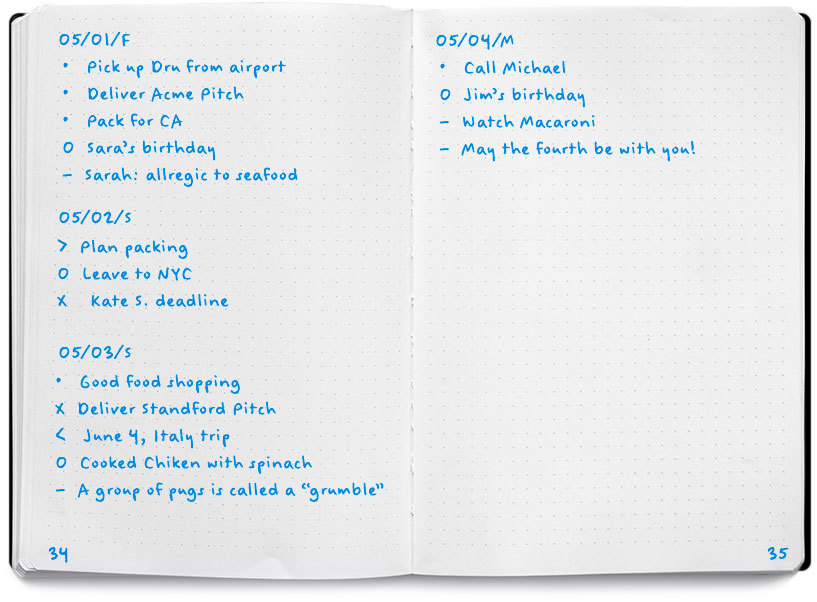What Is a Bullet Journal?
Bullet Notes is a customizable, loose note-taking system. It can be used as a to-do list, sketchbook, notebook or journal, and more often than not, it includes all of the above. It will make you do more with less. All you need is a pen and a notebook.
We don’t care about what we do when what we do doesn’t align with what we care about. When it comes to bullet journaling, our compass is our intent. Our intentions help us align our actions with our values. Without intent, we still have values and we still act, but the two are often at odds.
How to Make a Bullet Journal?
Every bullet journal should include these collections in the following order:
-Index: This section is at the front of your notebook and serves as a table of contents with page numbers to different collections and a symbol key that you update as you go.
-Future Log: This four-page spread is a year-at-a-glance calendar with future events, goals, and long-term tasks. Add birthdays, travel plans, and major holidays.
-Monthly Log: This two-page spread includes a calendar with a bird’s-eye view of the month and a task page with things you want to tackle during the month. You can also add other monthly tracking pages (“modules”) including a food, fitness, finance, or book log.
-Daily Log: This is your day-to-day to-do list.
While you should create a key that fits your needs, using the following symbols if you want to be a BuJo pro:
Tasks: •
Events: O
Notes (facts, ideas, and observations): —
Priority: *
Inspiration (mantras, insights, and ideas): !

5 Ways to Bullet Journal to Benefit Your Mental Health
Temi Manning, also known as Living Letter Plans, is a stationery and lifestyle influencer from the UK. She shared five ways you can bullet journal to care for your mental wellbeing, and how she uses these methods to help her in her journey with mental health issues.
1. Clear your mind
“I use my bullet journal for reflective journaling, like keeping a diary. I create weekly spreads, and at the end of the day unpack my thoughts and emotions.”
Getting your thoughts out of your head, and down onto paper is an extremely effective way of relieving stress and anxiety. The act of acknowledging your thoughts and writing them on paper, has a similar effect to talking with someone.
2. Use a mood and habit tracker
A mood tracker is a great way to have a very quick daily check-in with yourself. It gives you the chance to pause, think, and jot down how you’re feeling in yourself.
For example, I can jot ‘lack of sleep’ next to a low day, so that in future I know to make sure I priorities getting my 8 hours of sleep, or note ‘went for coffee with a good friend’ next to a very happy day, so I know to do that more often.
3. Create spreads to pick yourself up!
Simply create a spread that has a selection of actions you can take when you’re feeling low or stressed, that you know are effective in improving your mental state. You can also include encouraging quotes and sayings in your weekly spreads as mood boosters.
4. Be mindful
Mindfulness is a proven effective way of relieving stress and anxiety. All it requires is for you to be fully present, aware of where you are and what you’re doing, without allowing your mind to be over active or judgmental.
5. Enjoy your journal
Bullet Journaling is so enjoyable and sustainable because it is completely customisable, and it can evolve along with you.

Tips to Make a Bullet Journal
1. Set an Intent
If you never set an intent, now is the time. What do you want from your bullet journaling practice? What do you need? What problem are you trying to solve? What do you want to learn? Most importantly, why is this important to you?
You want to make sure you don’t fall into the trap of setting your intentions based on things you feel pressured or obligated to do.
2. The task description is more clear
Do not use vague adjectives such as “some”, “for a while”, etc. The words describing the task should be precise so that you can be sure that you have completed the set task. For example: “Complete 1/5 of the reading book and write down how you feel”.
3. Create a linked index with page numbers
How do I find out where the gunpowder is associated with this bullet? It’s very simple. Use the “page number” method to make links. For example, if a bullet task opens a new page to record related notes, then write the page number of that page back to the bullet list item, so that you can quickly check it.
Bullet Journal and Sleep
The bullet journal method can help us to make an effective sleep schedule.
After getting up in the morning, check the quality of sleep throughout the night on the Mintal Tracker app, and record the sleep score and sleep problems reflected from APP. This is done so that you can see if your sleep quality has improved after a while.
Record your dreams and feelings in time.
Journaling before going to bed at night will help us review our mood throughout the day and look forward to a better day.
The Mintal Tracker APP will also help you record the state before bed and provide you with a variety of high-quality white noise audio and relaxing guided meditation.









